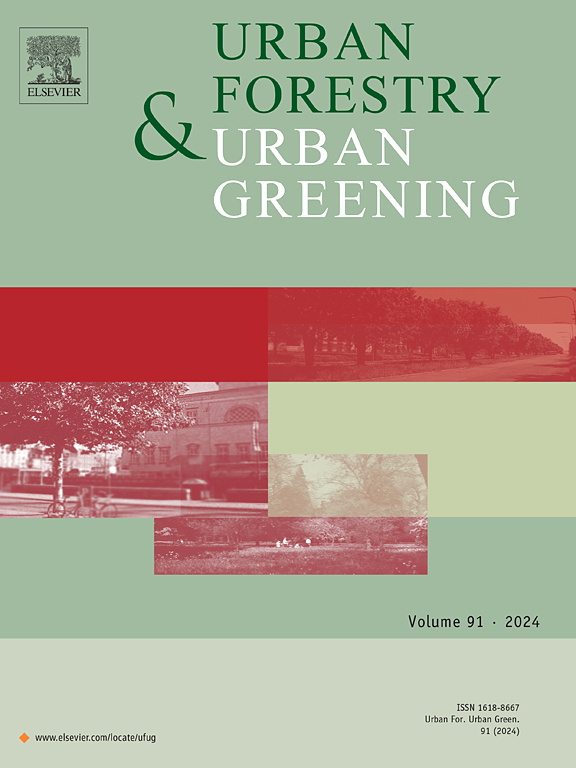Impact of environmental attractiveness and socio-economic status on residents’ green space visitation in northeastern China
IF 6
2区 环境科学与生态学
Q1 ENVIRONMENTAL STUDIES
引用次数: 0
Abstract
With the rapid development of green tourism in China, Jilin Province, a key forest area, is facing significant pressures related to green space utilisation and ecological preservation. These pressures arise from eco-tourism development amidst challenges such as a low economic level, high population density and limited land resources. This study explored the individual-environment interaction model for green space activities among residents with diverse economic and social backgrounds. Additionally, the study attempts to explain how residents’ negative tourism experiences affect their behaviors, thereby offering theoretical and empirical support for the forecasting of green space usage and the conservation of its value. An extensive online survey was conducted to assess residents’ green space activity patterns in three notable tourist cities in Jilin Province, and employed structural equation modeling to examine a series of hypothetical causal relationships among residents’ tourism frequency, visitation duration, socio-economic status, environmental attractiveness, and negative tourism experiences. The study revealed that the environmental attractiveness of the destinations exerted a greater impact on residents’ tourism behavior than their socio-economic status, with the influence of negative tourism experience being comparatively limited. Ownership of a private car and the choice to use it for tourism emerged as the most important variables within the socio-economic status. The type of green space was deemed an insignificant environmental variable. Tourism frequency exhibited a strong positive impact on visitation duration. These results enrich the empirical evidence for comprehending residents’ tourism decision-making processes, which is essential for the development of targeted adaptive policies.
环境吸引力和社会经济地位对东北地区居民绿地访问的影响
随着绿色旅游在中国的快速发展,作为林业重点地区的吉林省面临着绿地利用和生态保护的巨大压力。这些压力来自于经济水平低、人口密度高、土地资源有限等挑战下的生态旅游开发。本研究探讨了不同经济社会背景下居民绿地活动的个体-环境互动模型。此外,本研究试图解释居民负面旅游体验对其行为的影响,从而为绿地利用预测及其价值保护提供理论和实证支持。通过对吉林省3个著名旅游城市居民绿地活动模式的在线调查,运用结构方程模型分析了居民旅游频次、旅游时长、社会经济地位、环境吸引力和负面旅游体验之间的一系列假设因果关系。研究发现,旅游目的地的环境吸引力对居民旅游行为的影响大于社会经济地位,负面旅游体验的影响相对有限。拥有私家车和选择使用私家车旅游成为社会经济地位中最重要的变量。绿色空间的类型被认为是一个无关紧要的环境变量。旅游频次对旅游时长有显著的正向影响。这些结果为理解居民旅游决策过程提供了丰富的经验证据,这对制定有针对性的适应性政策至关重要。
本文章由计算机程序翻译,如有差异,请以英文原文为准。
求助全文
约1分钟内获得全文
求助全文
来源期刊

Urban Forestry & Urban Greening
FORESTRY-
CiteScore
11.70
自引率
12.50%
发文量
289
审稿时长
70 days
期刊介绍:
Urban Forestry and Urban Greening is a refereed, international journal aimed at presenting high-quality research with urban and peri-urban woody and non-woody vegetation and its use, planning, design, establishment and management as its main topics. Urban Forestry and Urban Greening concentrates on all tree-dominated (as joint together in the urban forest) as well as other green resources in and around urban areas, such as woodlands, public and private urban parks and gardens, urban nature areas, street tree and square plantations, botanical gardens and cemeteries.
The journal welcomes basic and applied research papers, as well as review papers and short communications. Contributions should focus on one or more of the following aspects:
-Form and functions of urban forests and other vegetation, including aspects of urban ecology.
-Policy-making, planning and design related to urban forests and other vegetation.
-Selection and establishment of tree resources and other vegetation for urban environments.
-Management of urban forests and other vegetation.
Original contributions of a high academic standard are invited from a wide range of disciplines and fields, including forestry, biology, horticulture, arboriculture, landscape ecology, pathology, soil science, hydrology, landscape architecture, landscape planning, urban planning and design, economics, sociology, environmental psychology, public health, and education.
 求助内容:
求助内容: 应助结果提醒方式:
应助结果提醒方式:


